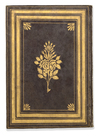AN OTTOMAN PRAYER BOOK SIGNED MUSTAFA RAKIM, TURKEY, 18TH CENTURY
Arabic manuscript on paper, 6 leaves with 13 lines to each page, written in elegant black naskh script, with gold verse markers, some words picked out in red, text within gold and black rules, opening biofolio with gold decoration. Depicting two famous prayers, Hizb al-Bahr by Sheikh al-Shadhili (593–656 AH/ 1196–1258 AD) who was an influential Moroccan Islamic scholar and Sufi, founder of the Shadhili Sufi order, and Hisb Imam Nawawi (631–676 AH/1234–1277 AD), who was a Sunni Shafi'ite jurist and hadith scholar. He authored numerous and lengthy works ranging from hadith, to theology, biography, and jurisprudence. In light green morocco binding with gilt floral motifs within two borders.
9 by 13 cm.
THE CALLIGRAPHER
Mustafa Rakim was born in Unye, Turkey, at the Black Sea in 1758. At a young age, his father Mehmed Kaptan, brought him to Istanbul to live with his brother, İsmail Zühdi Efendi an established calligrapher. After Ismail was appointed as an instructor of calligraphy at the Imperial Palace, the young Rakim received his formal training studying under his brother. Mustafa Rakim would become Ismail Zühidi's most celebrated pupil.
Ismail Zühidi and Mustafa Rakim developed their own style of calligraphy based on the work of Hafiz Osman. They were able to develop a style of Thuluth script that was aesthetically pleasing, something that other calligraphers had not been able to do. Râkim also reformed the calligraphic shape of the Tughra script.
With the revolutionary changes brought about in calligraphy by Mustafa Rakim, scholars treat Turkish calligraphic art history into two key eras: 'Pre-Rakim' and 'Post-Rakim'. He was able to accomplish what nobody before him could in the Jali-Thuluth script and tughras of sultans. By finding the ideal measurement between the letter thickness and pen (writing tool) thickness, he established the style and form for the ideal beauty of Tughras.
He is regarded as the first great Turkish painter in the Western sense of painting. His bird painting is considered to be the first realist work of Turkish painting. He made a portrait of Sultan Selim III who was amazed by his work and recited a poem in his honor in return.




